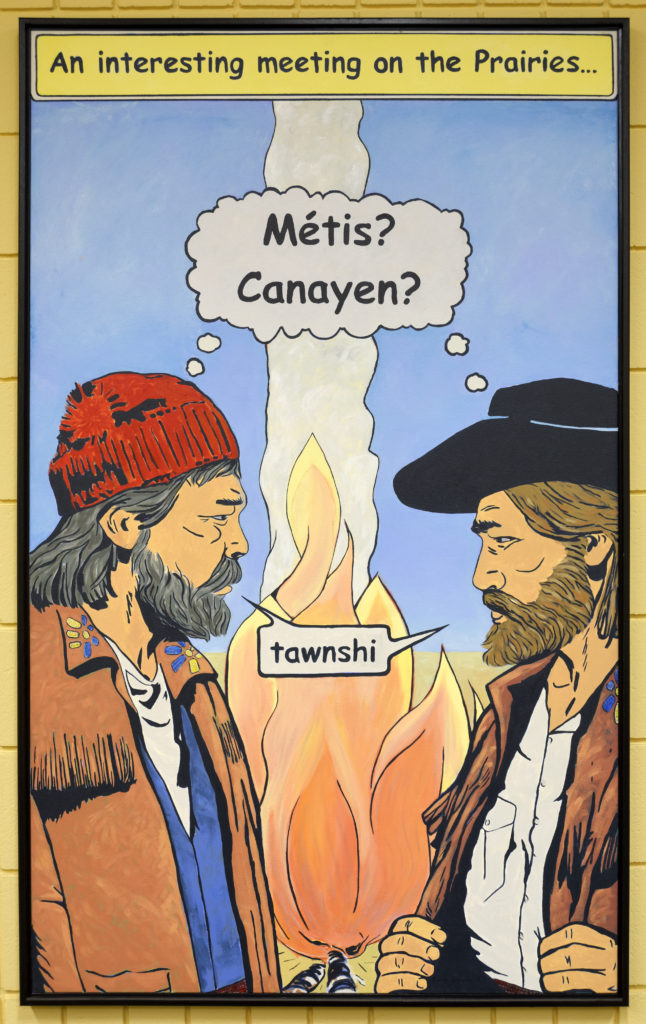
David Garneau, An Interesting Meeting on the Prairies, 2005. Acrylic on canvas, 61″ x 37″. University of Regina President’s Art Collection; pc.2006.4. © David Garneau. Reproduced with the permission of the artist. Photograph by the University of Regina.
Saskatchewan has a rich history of artistic practice which is represented in the President’s Art Collection. Our holdings include the modernist abstractions of the Regina Five, Indigenous sculpture, textiles and painting, and ceramics in the Regina Clay tradition.
Jack Sures (1934-2018), was a longtime professor at the University of Regina, founded the University’s ceramics program in 1965. Examples of his work can be found throughout the campus, including a selection of vessels (Classroom Building, 1st floor hallway, outside CL 111), his 1972 ceramic mural (Classroom Building, 2nd floor staircase) and sculptural objects (Classroom Building, hallway CL 401.2). Other holdings representative of the Regina Clay tradition include Ann James, Lorraine Malach, Marilyn Levine and Victor Cicansky*, all members of a generation of ceramicists who emerged under Sures. For more information about ceramics at the University of Regina, click here.
The Regina Five pioneered modernist abstraction in Canada, and remain some of the city’s most influential artists. Arthur McKay (1926-2000), Douglas Morton (1926-2004), Ted Godwin (1933-2013), Kenneth C. Lochhead (1926-2006) and Ronald Bloore (1925-2009) formed a hub of avant-garde activity in the early sixties, in and around the University of Regina School of Art and the Norman MacKenzie Art Gallery. The Five exhibited their abstract painting at the National Gallery of Canada exhibition, Five Painters from Regina in 1961; a significant moment of national exposure. McKay and Lochhead initiated the Emma Lake workshops. The workshop series was led by renowned invited artists and critics, many from New York, which was considered the centre of the artworld at the time. Not only did these cultural practitioners influence the Five, but many others who attended from throughout coast to coast. To view the work of the Five together, visit the Dr. William Riddell Centre.
Anthony Thorn (1927-2014) originally studied under the Regina Five member, Kenneth Lochhead, and was instructed in oil painting in Canada, stained glass and drawing in Paris, metal-smithing in Greece, mural work in Mexico, and watercolour and sumi-e (ink wash) painting in Japan. Three of his paintings, on display in the Dr. Archer Library, reflect his painterly skills.
The University also has several paintings by contemporary Métis artist, curator, writer and academic, David Garneau (b. 1962). An Associate Professor in Visual Arts in the faculty of Media, Art, and Performance, Garneau’s work is directly influenced by Métis material culture, and explores issues such as Métis identity, politics and indigenous and settler dynamics. The works can be viewed in the Dr. William Riddell Centre and La Cité.
In 1970, the University commissioned three Tah-hah-sheena tapestries from the Sioux Handcraft Co-operative by Bernice Runns, Marjorie Yuzicappi (dates unknown) and Martha Tawiyaka (1875-?) which can be viewed in the Dr. Archer Library. Located on Standing Buffalo, SK, the Co-operative began with twenty-three rug-hooking enthusiasts seeking to revive local Sioux designs. Also on display within the Dr. John Archer Library are Keith Bird‘s (b. 1955) monumental hide paintings, The Clans (2009) and Spotted Thunderbird Healer (2010). An accompanying work, Elk Whistle (2006), is displayed in the Aboriginal Student Centre in the Research and Innovation Centre. Bird’s works speak to the reclamation of traditional spiritual practices and teachings and are informed by his Cree and Saulteaux heritage.
Contemporary Cree artist Lionel Peyachew’s The Four Directions (2005) honours the teachings and philosophies of elders and reflects on the importance of education as a tool to thrive. This sculpture can be viewed next to Wascana Lake. Like Peyachew, Allen Sapp (1928-2015) was raised on Red Pheasant First Nation, Saskatchewan. Horses Drinking (c. 1983) and Threshing in the Old Days (date unknown) are typical of the warm and evocative scenes of Sapp’s oeuvre, and can be viewed in the Administration Humanities Building on the first floor. For more information about these and other indigenous artworks on campus, click here.
Joseph Fafard‘s (b. 1942) outstanding cultural contributions have significantly raised the profile of art in Saskatchewan. Over an art career that spans four decades, Fafard has developed a national and international reputation for his ceramic and bronze works, which include Le jardin d’esprit (1997), located next to Wascana Lake. Fafard’s collaboration with his class, Frog (1971), remains one of the most popular public sculptures in Regina today.
*For more information about these works, contact presidents.art.collection@uregina.ca


